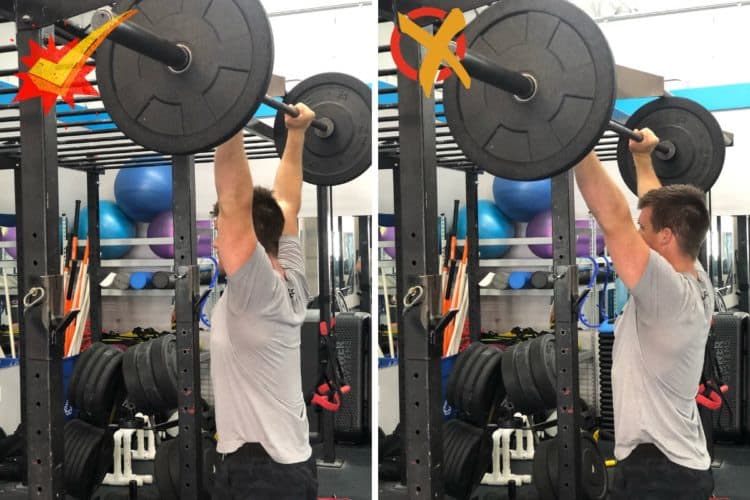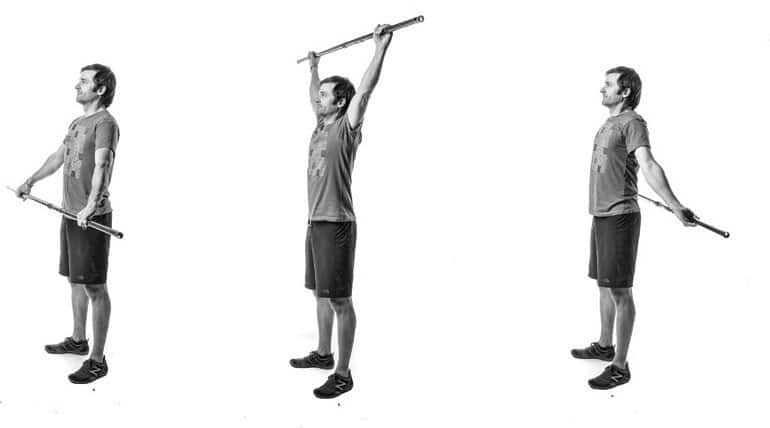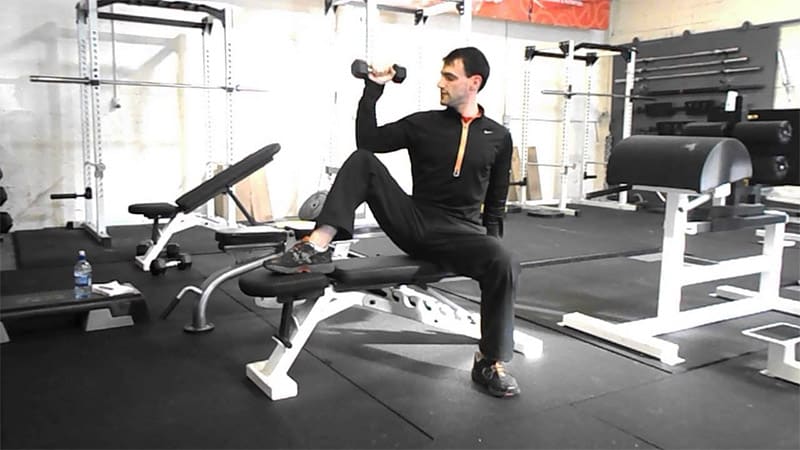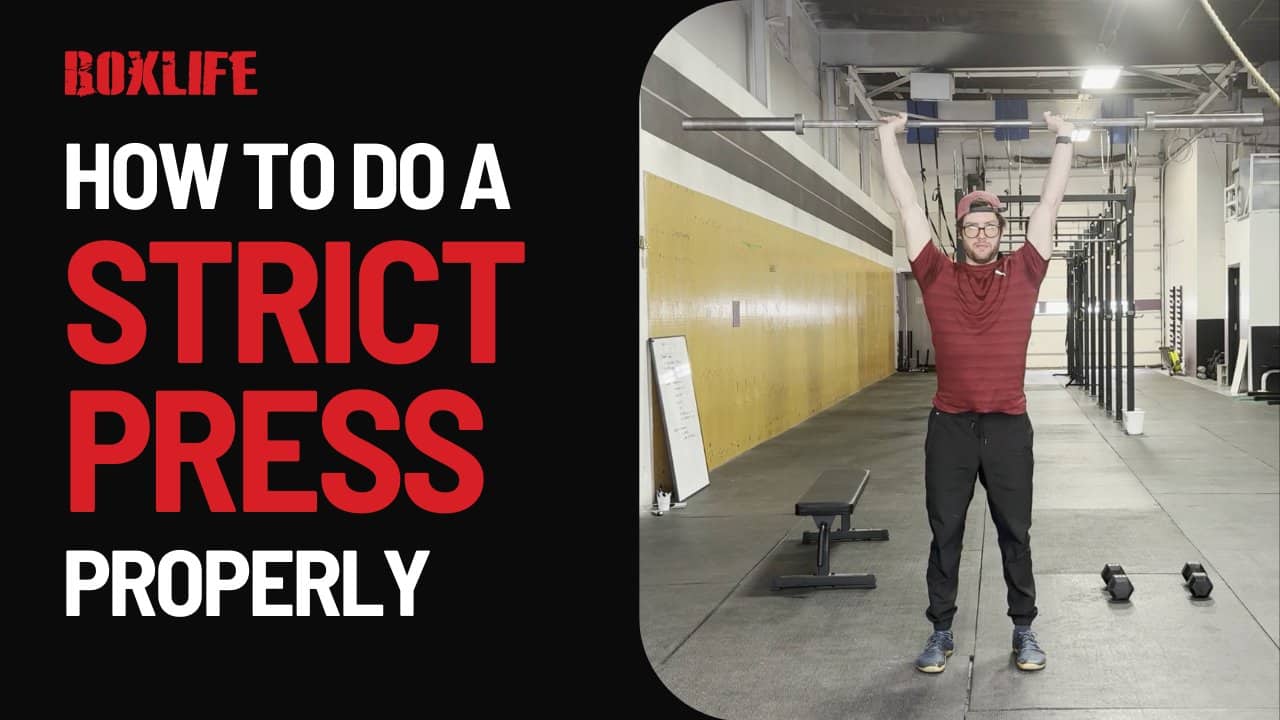Jump to:
- What is a Military Press?
- Benefits of the Military Press
- Muscles Worked by the Military Press
- How to Perform the Military Press with Perfect Form
- Military Press Progression
- Common Mistakes in the Military Press
- Tips to improve your Military Press
- Military Press Variations
- Military Press Alternatives
- Equipment needed
- Military Press FAQs
What is a Military Press?
The Military Press is the most basic exercise for developing strength in the overhead press. It is performed with a barbell and involves only upper body movement, bringing the barbell from the front rack position, overhead. The shoulders, traps and triceps are the primary muscles used, but with heavy weights, it utilizes almost all muscles of the upper body.
Benefits of the Military Press
The Military Press should be incorporated sometime of the year in all upper body exercise programs. Few exercises develop such upper body strength and shoulder hypertrophy.
Prefer video? Here’s a complete tutorial we did on this specific movement:
A basic exercise leading to other important weightlifting movements
The Military Press involves no leg movement. However, in order to be able to perform other movements in CrossFit and weightlifting, such as the Push Press, Push Jerk and Split Jerk, you must be strong in the Military Press. Those exercises use leg drive mostly in order to bring the barbell overhead, but shoulder strength and stability are better developed with no leg drive.
Develops core strength
The Military Press is primarily a shoulder exercise, but when using heavy weights, stabilizing eventually becomes harder, and this is where core stability is developed.
Increases shoulder mobility
Most people who start lifting weights will struggle locking their arms with a barbell overhead. When performing the Military Press, make sure that the barbell stays close to the body’s center of gravity and try getting full lockout at the end of the movement. This will increase your shoulder mobility and will prime your body before starting to do other overhead movements such as the Push Press, the Jerk, and even the Snatch and Overhead Squat.
Muscles Worked by the Military Press
The Military Press is an amazing strength exercise, involving almost all muscles of the upper body.
The primary muscles that work to bring the barbell overhead are the shoulders, the triceps, the traps. However, other muscles involved are:
- Upper chest: Works mostly during the first phase of the push, where the barbell is still low.
- Back: The lats and rhomboids provide shoulder stability.
- Core: The core is involved to provide a stable base.
- Biceps: The biceps are also functioning during the movement to provide overhead stability.
- Forearms: The forearms are the main muscles for grip strength. All barbell exercises provide forearm development
How to Perform the Military Press with Perfect Form
Step #1: The Starting Position
The rack should be placed at shoulder level. Lift the barbell with your shoulders, with your elbows slightly in front of the barbell and your palms facing forward and slightly up. Raise your chest high to prevent the barbell from touching your collar bone. Squeeze your glutes, activate your core, lats and protract your scapula using your traps to get a stable front rack position.
Start with you feet shoulder-width apart, or slightly narrower, between hip width. The heels, hips and barbell should be vertically aligned.
Step #2: The press
Before starting to lift the barbell, take a deep breath and hold it until the barbell is sitting overhead. That way your upper body will stay tight and you will decrease the chances of losing stability.
Press by utilizing the majority of your upper body, not only the arms. This is something not everyone can do when starting to lift, but will eventually happen with practice.
Another thing you need to watch out for, is the bar path. Tuck your chin and bring your head slightly backwards so that the barbell doesn’t travel around your head. Instead, you want the bar path to be as straight as possible.
Step #3: The lockout
When finishing the movement, make sure your elbows are locked and the barbell is over your head and not in front of you. If you suffer from thoracic mobility, work with lighter weights to prevent shoulder injuries.
Lastly, avoid curving of the lower back by squeezing your glutes to prevent damaging your lower back. This will also increase overhead stability.
Military Press Progression
Although the Military Press may look simple to execute, not everyone is capable of performing it correctly at first. Thoracic and shoulder mobility are challenged when the barbell is lifted overhead.
If you experience discomfort when performing the Military Press with a barbell I would suggest using some regression exercises to get comfortable with the overhead position first.
Single Arm Banded Overhead Press: This exercise is a basic form of overhead pressing. By working unilateral, this pressing exercises corrects imbalances and improves stability, mobility and strength, emphasizing in the last part of the movement, the lock-out, which is the most challenging part.
Overhead Walking Carry: This is an amazing exercise that will help you develop core strength specifically for the Military Press, while also getting you familiar with the overhead position.
Dumbbell Press: Although the Dumbbell Press is another great shoulder exercise, it can be used by beginners to build shoulder strength and mobility before grabbing a barbell. Dumbbells are easier on the shoulders, they building unilateral strength, prepping the body for the Military Press.
Common Mistakes in the Military Press
In my coaching career, the most frequent mistakes that happen during the Military Press (other than poor form that can be coached to be corrected) have to do with poor thoracic mobility and limited overhead strength and stability. Those issues should be addressed prior to starting to add weight to the barbell (will cover this in the next part of the article). Here are some coaching cues that should be taken into account in order to achieve good form in the MIlitary Press.
Mistake #1: Pressing the barbell forward

This is typical to athletes who have limited thoracic and shoulder mobility, struggling to lock the weight overhead. It’s best to work on mobility and other pressing variations to achieve full lockout overhead before performing the Military Press.
Keep the path of the bar straight as possible. If you find that your head is coming in the way of the barbell, tuck your chin in and bring your head slightly back.
Mistake #2: Back arching

This mistake goes hand-in-hand with the first one. When you have someone who is pressing the barbell forward try to get it overhead, this is the picture you will most likely get. Lumbar spine arching to compensate for the limited thoracic mobility.
Mistake #3: Excessively wide grip
I don’t know if this belief is worldwide. However, where I come from it is still believed that a wide grip during presses and pulls will get you a wide back and broad shoulders.
The only thing you will get from an excessively wide grip is most likely a shoulder injury. In order to do the Military Press correctly grip should be slightly wider than your shoulders. By doing so, you’ll bulletproof your shoulders by using the bigger muscles to press the barbell.
Mistake #4: Elbows direction

Mostly a beginner’s mistake, but it’s easily corrected. When performing the Military Press, your elbows should point slightly in front of you in the front rack position. During pressing, avoid flaring your elbows to the sides while maintain the external rotation for the majority of the movement (think of your armpits looking forward). This will prevent you from injuring your shoulders while providing stability to the movement.
Mistake #5: Incorrect wrist position
To prevent wrist pain in the Overhead Press and other barbell exercises such as the Seated Military Press, make sure to not overextend your wrists and let the barbel apply excessive pressure on these small joints. A helpful tip would be to raise your elbows high and grab the barbell with a full grip, not letting the wrist to stretch. Lastly, do not forget to warm the wrists up extensively as wrist pain is very common among athletes who perform Military Presses.
Tips to improve your Military Press
Bulletproof your shoulders
Before attempting to go heavy on the Military Press, make sure to prep the shoulder and upper body for it. Here are some shoulder exercises that will help you perform the Military Press correctly:
PVC Pass-through

The PVC Pass through is an amazing warm-up exercise for the shoulder and rotator cuff. You can perform them before a shoulder training day.
Lower Trap Reverse Flyes
This is an amazing exercise for people who suffer from back pain, but it’s a great exercise to improve shoulder health and thoracic mobility as well.
Dumbbell External Rotations

A great exercise to strengthen the external rotators of the shoulder. Doing so will decrease your chances of a shoulder injury and increase stability in the shoulder joint during the Military Press.
Start light and progress slowly
When starting out, avoid loading the barbell excessively. It is best to get used to the movement first by performing sets of 15-20 reps with less weight. That way you will give time to the body to adapt to the new movement without the risk of injury. Additionally, you should not rush to adding weight to the barbell. 1lb and 2lb plates should be your friend when progressing.
When warming up, use a PVC pipe and go through the movement for 20-30 reps making sure you meet all the necessary cues before moving onto a barbell.
Military Press Variations
The Standing Military Press is a basic barbell movement that involves overhead pressing in a standing position. However, variations are plenty, as you can perform a shoulder press in many different ways and positions. Here is a list of some Military Press variations:
Seated Military Press
The seated Barbell Military Press is great to improve arm and shoulder movement during the Military Press, as it excludes the lower body. By doing so, you’re focusing solely on proper form in the shoulders and arms, resulting in a more strict movement with absolutely no hip or leg drive, teaching proper technique for the Standing Military Press.
Bench Press
The Bench Press is a horizontal pressing movement, focusing more on the chest than the shoulders. It is considered one of the most popular barbell exercises.
Dumbbell Strict Press (+ Seated)
The difference between a barbell and a dumbbell movement is most commonly the fact that dumbbells require more stabilization than a barbell. Additionally, barbell movements tend create imbalances between the left and right part of the body. A great variation to focus on unilateral strength and shoulder stability.
Barbell / Dumbbell Push Press
The Push Press is considered a full-body Military Press. The main force production comes from the hip and the legs. With a tight core, the leg drive transfers to the bar to accelerate it upwards, while the arm push until lockout. Great to work on explosive strength and core-to-extremities movements (big muscles first, small muscles finish). As you progress in the Push Press, you will be able to lift more weights than in a Military Press.
Single Arm Dumbbell Push Press
By working one arm at a time you will be able to focus better on each side of the body, observe and fix imbalances, while working the opposite part of the core muscles to counteract for the weight side-by-side difference.
Behind The Neck Strict Press
A great accessory for the Military Press mostly used by Olympic Weightlifters to work on thoracic and shoulder strength, and upper back mobility.
Snatch Grip Push Press
A snatch grip is a wide barbell grip on the bar that is used specifically for the Snatch, an Olympic Weightlifting movement that you bring the barbell from the ground to overhead in a single motion. The Snatch Grip is more taxing to the arms and shoulders, so performing the Snatch Grip Push Press will increase positional strength and mobility in the Snatch.
Jerk
The Jerk is an Olympic Weightlifting movement that involves full body movement. The first part of it looks like a Push Press, but is followed by an explosive dip in a quarter squat under the bar. The dip takes off some of the strength needed to press the barbell overhead, using more momentum and less muscle activation. As you eventually get better in the Jerk, you will be able to lift more weights than in a Military Press or Push Press.
Dumbbell / Barbell Sotts Press
One of my favourite accessory exercises. The Sotts Press involves a press while your in deep squat position. This will tremendously help with shoulder mobility and stability. Personally, I believe this exercise to be a great checkpoint for an athlete to achieve in order to progress in CrossFit and Olympic Weightlifting
Military Press Alternatives
The Military Press is a basic upper body exercise that almost all CrossFitters, Olympic Weightlifters, and bodybuilders can benefit from. If you struggle with it, due to lack of equipment or injury, you can still benefit from other exercises. Below I have a list of exercises that you can perform if you’re unable to perform the Military Press correctly and pain-free.
Push-up
The Push-up is the most basic bodyweight pressing movement and a great exercise to improve general strength and improve your standing barbell press strength. The Push-up can be progressed in many different ways so that even advanced athletes can perform it and benefit from it
Elevated Push-up
The Elevated Push-up is a progression of the Push-up that increases the weight that the body has to lift, while also transferring more weight to the shoulder muscles instead of the chest.
Parallette Dips
The Dips is a pressing movement that is performed in the opposite direction of the Military Presses. Olympic Weightlifters also perform this exercise for strength development, to improve overhead stability, and to counteract for the excessive overhead pressign they do in training to prevent injury.
Ring Dips
The Ring Dip is a dip performed on the rings. If you ever held yourself on a pair of rings you will have noticed the stability and balance needed to even stay still. Rings tremendously improve stability and fire the smaller muscles much more than Parallettes.
Dumbbell Lateral Raises
This exercise is a great shoulder accessory exercise for focusing on different muscles that may assist with stability and injury prevention. There is also an incline bench variation that will focus on the posterior side of the shoulder, an important exercise for shoulder health.
Equipment needed
In order to perform the Military Press the only equipment needed to begin is a barbell and some plates. A rack could be helpful so that you don’t have to lift the barbell from the ground. If a rack is not available, try working on your Power Clean technique to bring the barbell safe to your shoulder.
If a barbell is not an option, The Military Press and many other exercises can be performed with dumbbells, or even just your bodyweight.
Military Press FAQs
Is the Military Press necessary for upper body development?
The Military Press is one of the most basic upper body exercises, but you can still get great results with other movements (bodyweight or dumbbells).
Is the Military Press safe to perform?
The Military Press is overall safe to perform, however a basic shoulder and thoracic mobility is required, thus you should proceed carefully and perform warm-up and mobility exercises prior to it.
How to do the Military Press with no barbell?
You can perform overhead presses with dumbbells and kettlebells, or you can try the elevated push-up if there no equipment available.
Which muscles does the Military Press work?
The Military Press primarily involves the shoulder, traps, and triceps, however it is a compound exercise, which means that it works a variety of muscle groups as well, such as the back, chest, biceps and the core.















